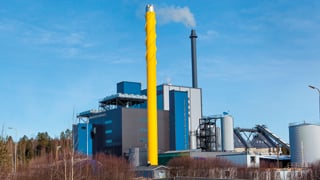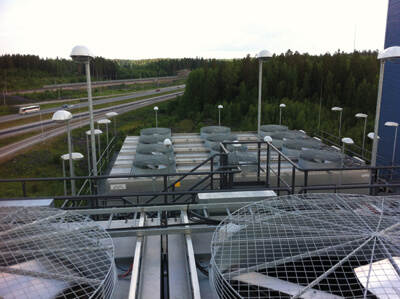The cooling side of district heat and electricity in Finland
Fortum’s new biofuel-fired CHP plant at Järvenpää, Finland produces both district heat and electricity. Alfa Laval air heat exchangers provide reliable, cost-effective cooling for the plant.
DATE 2023-11-28
Biomass efficiency from Fortum
In June 2013, Fortum in Finland inaugurated a new biofuelfired CHP plant that produces about 280GWh of heat annually to provide district heating for 34,000 people in the towns of Järvenpää and Tuusula, in addition to supplying about 130GWh of electricity to the Finnish national grid. The fuel for the new Fortum plant at Järvenpää consists of forestry industry by-products that include wood chips, sawdust and bark – all sourced within a 100-kilometre radius of the plant. The new CHP plant has therefore been sited next to the Helsinki–Lahti motorway, well away from residential areas so local residents are not unduly inconvenienced even though about 35 truckloads of biofuel arrive at the plant every weekday.
Fortum is the largest generator of energy in Scandinavia and the fourth-largest in the world, currently operating a total of 18 combined heat and power (CHP) plants. Fortum is also the leader in using biomass for energy production in the Baltic region. The low-emissions plant in Järvenpää in Finland – identical in concept with its bigger counterpart in Jelgava in Latvia – has been built to comply with the very latest international standards for energy efficiency and environmental responsibility.
Reliable, energy-efficient cooling makes a big difference
Effective cooling is crucial for ensuring maximum reliability at a plant like Järvenpää. Just as in the other Fortum CHP plant in Jelgava, Alfa Laval provided equipment to undertake two different types of cooling duties. Four air heat exchangers are installed as closed loop coolers for dissipating the excess heat from turbine lubrication oil, the main circulation pump and generator. An additional five Alfa Laval air heat exchangers are installed as auxiliary coolers to deal with the excess heat in the district heating loop during the summer period.
Identical units were designed for both types of cooling, thus reducing the initial investment as well as rolling back subsequent maintenance and spare parts costs. The remarkably low energy consumption of Alfa Laval air heat exchangers also contributes to the overall energy efficiency of the Järvenpää power plant by ensuring minimal load to the boiler in the summer, using as little electricity as possible. Fortum is then able to generate additional revenue by selling the electricity thus saved to the Finnish national grid.
As Juha-Matti Kuoppala, Product Portfolio Manager at Alfa Laval Vantaa, explains, ”We delivered nine liquid coolers to Fortum for the Järvenpää plant, each weighing approx. 6,000 kg. To make the maintenance and operation of these coolers easier, the fans of each unit are substantially bigger than normal. They are each two metres in diameter – many times the size of our conventional solutions.”
“Fortum particularly appreciated the high quality of the new equipment, as well as the practical benefits of the Alfa Laval air heat exchanger plant being located in Vantaa, only 25 kilometres away. This made transport of the coolers very easy,” tells Kuoppala.
Heikki Jaakkola, Project Manager at Fortum, supervised the acquisition and design processes, emphasizing that;
In a delivery of this scale, all the equipment must work correctly. Because the cooling medium is air, the solutions we use must work in all situations and under all conditions. We therefore place big emphasis on high quality.”
”Alfa Laval air heat exchangers have an extremely long service life, because the components and materials used have been carefully selected to fulfil the demanding industrial requirements. Alfa Laval provides its customers with a product optimized to their specific needs, installed as part of an overall solution. This is a clear strength compared to our competitors,” explains Kuoppala.
Heikki Jaakkola at Fortum also highlights the practical benefits of the strong cooperative mind-set that characterized the working relationship between Fortum and Alfa Laval. This meant that if any problems arose or shortcomings occurred, the matter was brought up immediately and then solved openly and in a constructive spirit. As Jaakkola points out;
I was already familiar with Alfa Laval heat exchanger products, as Alfa Laval had delivered the same cooling equipment to Fortum’s corresponding power plant in Jelgava in Latvia. I therefore knew that the heat exchangers are made using high-quality materials and under strict supervision, and the Jelgava solution had already brought us significant cost savings.”
Installation-ready package
In addition to the cooling equipment, Alfa Laval also supplied Fortum with the requisite control units. “Using the right kind of control unit makes it possible to ensure the efficient, economical use of the plant,” explains Kuoppala. Kuoppala continues: ”All the wiring and the electrical connections were done at the factory, providing the customer with a complete, installation-ready package, right down to the last detail. This saved a considerable amount of time in the installation phase, which our customer experienced as a plug-and play process that was essentially problem-free.”
